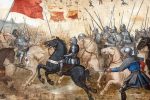Yorkshire’s Cistercian Abbeys & The Wandering White Monks of Yorkshire

By Richard Smyth
Life is seldom comfortable when you’re a monk. Lots of praying, lots of work, not much in the way of home comforts. But the modern-day monk has it relatively easy. When you’re a monk in Dark Ages Yorkshire, life is tough.
The history of Yorkshire’s Cistercian abbeys reads a little like a family tree, or perhaps like some sort of monastic relay-race. It all began in the history factory that is York, at St Mary’s Abbey (large bits of which can still be found in the city’s Museum Gardens). In 1132 the Benedictine monks at St Mary’s started bickering over certain points of order. As so often when monks bicker, this soon escalated into a full-scale riot. Thirteen monks were politely asked to leave.
These monks were reformers. The Order of Benedict was just a little too comfy for them. These monks wanted to suffer in the service of their religion. And suffer they would.
 On leaving York, the reformists were granted a plot of land by Thurstan, Archbishop of York. It wasn’t what you’d call prime real-estate. The monks’ new home was in the valley of Skell, in the wilderness to the west of Ripon. One chronicler described the spot as ‘more fit for wild beasts than men to inhabit’ – but it had timber, and water, and shelter, and was therefore more than enough for the hard-as-nails followers of the new-fangled Order of Cistercians.
On leaving York, the reformists were granted a plot of land by Thurstan, Archbishop of York. It wasn’t what you’d call prime real-estate. The monks’ new home was in the valley of Skell, in the wilderness to the west of Ripon. One chronicler described the spot as ‘more fit for wild beasts than men to inhabit’ – but it had timber, and water, and shelter, and was therefore more than enough for the hard-as-nails followers of the new-fangled Order of Cistercians.
“Almost starved”
The abbey the exiles founded at Skell was accepted into the Cistercian Order in 1135. Cistercians were old school. Whereas the Benedictines of St Mary’s had to some degree moved with the times, the Cistercians insisted on keeping it real: they demanded full and literal compliance with the Rule of St Benedict, laid down in around 500. The Rule is traditionally summed up in a simple phrase: ‘Work and pray’.
Strenuous manual labour took up much of the time of the monks of Skell. They ate hardly at all, and spoke even less. Their monastic robes were nothing but cloaks of untreated sheep’s wool – made particularly uncomfortable by strict rules prohibiting the wearing of underwear.
The monks’ home in the Skell valley soon became known as Fountains Abbey. But for some, it would not remain home for long; for these monks, their destiny lay to the south.
A party of Cistercians left Fountains in 1147. Their destination was a new monastery, funded by local noble Henry de Lacey. It was in Barnoldswick (then Bernolfwic), a few miles north of modern-day Burnley. Few monks can ever have suffered like the Cistercians suffered at Barnoldswick.
For a start, it was freezing cold and rained incessantly. The monks almost starved. Roaming roughnecks stole or ruined their property (such as it was). And things got even worse when the monks tried to get tough with the local churchgoers.
 “High-handed conduct”
“High-handed conduct”
In establishing their new home in Barnoldswick, the monks had driven out the local villagers, who seem to have taken this development in their stride – save for the fact that they insisted on returning to the site in order to attend church. The monks were not standing for this. Their solution was simple: they pulled down the church.
They then decided that it might be a good idea to skip town. They consulted de Lacey. Yes, he said, he had just the place for them – a spot by the river Aire, not far from the town of Leeds. It was ‘remote from the habitation of man’, of course, but that was what the Cistercians wanted. And it already had a (supposedly) spiritual heritage: in the early 1000s, a visionary shepherd named Seleth was said to have wandered to Kirkstall from ‘the south’ and established his hermitage there.
So the site that would later be Kirkstall Abbey was cleared of its hermits, vagrants and other wildlife and settled by the monks in 1152. The recently de-churched villagers of Barnoldswick, meanwhile, lodged complaints with the local Archbishop and, ultimately, the Pope about the high-handed conduct of the invading monks. The Archbishop and the Pope were both Cistercians. The complaints were ignored.
 “Formidable ironworks”
“Formidable ironworks”
One of our best sources for the early history of Kirkstall Abbey is one ‘Serlo’, an elderly monk who, in the best traditions of Dark-Ages history, may or may not have existed. Hugh de Kirkstall, a Cistercian who was commissioned as the Abbey’s in-house chronicler, claimed that his history of the Fountains and Kirkstall Abbeys had in fact been dictated to him by Serlo, a veteran of the monks’ Fountains Abbey salad days and of the Barnoldswick debacle: this Serlo describes himself in the history as ‘a man now decrepit, as you see, and worn out with old age’.
This elderly Cistercian – who, if he ever lived, presumably died at Kirkstall – enjoyed a relatively peaceful existence with his fellow monks on the banks of the Aire. Like most monks of the day, the Kirkstall ‘White Monks’ were skilled and diligent craftsmen; metalwork was a particular speciality, and a formidable ironworks would be maintained at Kirkstall long after the monks were gone.
Another feature of the monks’ existence may be surprising to those familiar with the Cistercian creed (but not, perhaps, those familiar with the history of church institutions down the ages). The White Monks were simply rolling in money. By 1300, the abbey had acquired 216 draught oxen, 160 cows, 152 bullocks, and 4,000 sheep and lambs. By the 1530s, the White Monks were pulling in around £10,000 a year – excluding the value of their livestock and lands.
Extract taken from ‘Bloody British History: Leeds’ by Richard Smyth, published by The History Press










The strange case of Yorkshire’s wandering white monks … http://t.co/uHciNWqwWY #yorkshire #history
YORKSHIRE HISTORY: The curious case of Yorkshire’s Wandering White Monks … http://t.co/uHciNWqwWY #yorkshire
YORKSHIRE HISTORY: The Wandering White Monks of Kirkstall and Fountains Abbey … http://t.co/7st7PznC3P @TheHistoryPress #yorkshire